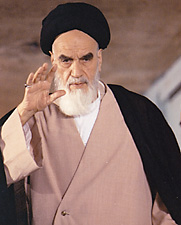Khomeini, << koh MAY nee or hoh MAY nee, >> Ruhollah (1900?-1989), an Islamic religious leader, was the chief political figure of Iran from 1979 until his death on June 3, 1989. He came to power after his followers had overthrown Mohammad Reza Pahlavi, the shah (king).

Khomeini made Iran an Islamic Republic and put Islamic laws into effect. These laws included many restrictions on the activities of the people. For example, the people were forbidden to drink alcoholic beverages.
In October 1979, the shah—who had fled from Iran—was admitted to a hospital in the United States. In November, Iranian revolutionaries took over the United States Embassy in Tehran, Iran. They held as hostages a group of Americans, most of whom worked for the embassy. Khomeini supported the revolutionaries, who said they would hold the hostages until the shah was returned to Iran for trial. The shah died in July 1980. The hostages were released in January 1981. During Khomeini’s rule, Iran fought a destructive war with neighboring Iraq over territorial disputes and other disagreements. After nearly eight years of fighting, the countries reached a cease-fire in 1988.
Khomeini’s original name was Ruhollah Moussavi. He was born in Khomein, a town south of Tehran, probably on May 17, 1900, and changed his last name to Khomeini. In the 1920’s, Khomeini became a teacher of Islamic philosophy and law. Khomeini earned the title ayatollah, a Persian word meaning reflection (or sign) of Allah. This title is the highest that can be held by a member of the Shiite division of Islam. Khomeini became the chief figure among the Shiites in Iran in the early 1960’s. In 1963, he was imprisoned for opposing the shah. Khomeini was exiled in 1964, but he continued to work for the overthrow of the shah.
